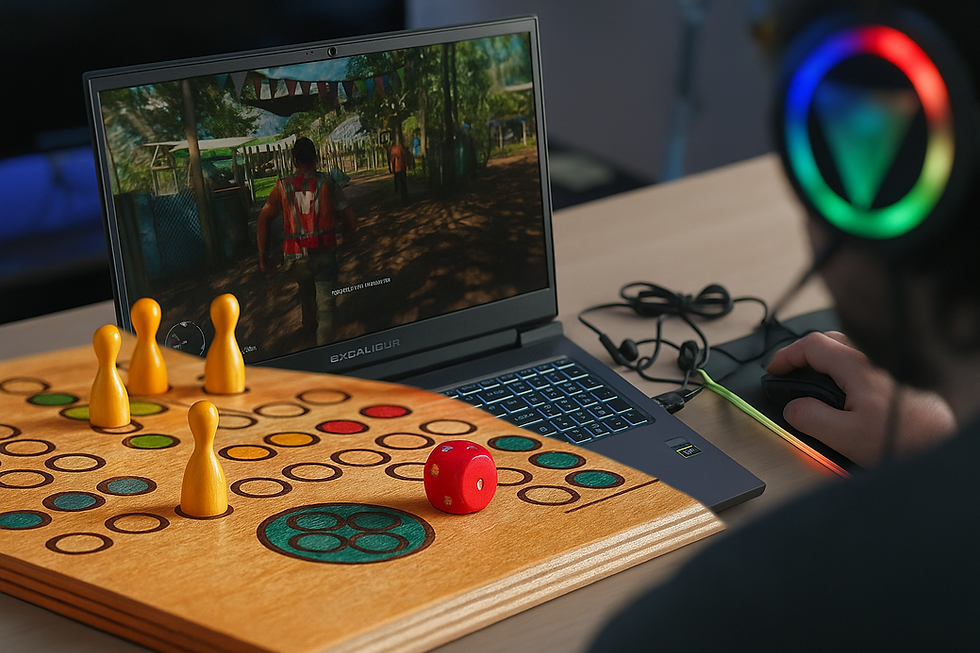Board Games in Education: How Play Transforms Learning
- shahmeerarshad008
- Aug 28
- 4 min read
Table of Contents
1. Introduction: Rethinking Learning Through Play
When you picture a classroom, what comes to mind? For most of us, it’s rows of desks, textbooks, and lectures. But education is evolving, and so is the way children learn best. One powerful (yet often underestimated) tool is board games in education.
Far from being “just fun,” board games foster problem-solving, social skills, focus, and even emotional resilience. Teachers worldwide are experimenting with incorporating classroom board games to engage students in meaningful learning experiences.
In this blog, we’ll explore how educational play through board games transforms learning environments, the different kinds of games that suit classrooms, and how modern digital platforms are making this approach even more accessible.

2. Why Board Games Belong in the Classroom
The Psychology of Play and Learning
Children naturally learn through play. According to educational psychology, play-based learning helps kids internalize concepts more effectively because they’re emotionally engaged. Unlike passive listening, games demand participation, decision-making, and reflection.
Building Critical Thinking and Problem-Solving Skills
Games like Chess or Go challenge students to analyze situations, anticipate outcomes, and make thoughtful choices. These mental exercises directly strengthen skills needed in academics, from math problem-solving to scientific reasoning.
3. Types of Educational Board Games
Board games come in many forms, each targeting different aspects of student engagement and development.
Strategy-Based Games
Games such as Chess, Go, or Checkers encourage long-term planning, logic, and patience. These are ideal for teaching strategic thinking and resilience.
Math and Logic Games
Titles like Sudoku-inspired board games, Mancala, or even simpler counting games help children grasp numbers, probability, and logical sequencing.
Language and Word Games
Games like Scrabble or Boggle are classic examples of how board games can enrich vocabulary, spelling, and communication skills while being fun and competitive.
Social and Cooperative Games
Cooperative board games (where players work together instead of competing) are particularly effective in classrooms. They nurture teamwork, empathy, and negotiation skills—qualities essential for both academics and life.
4. Benefits of Board Games for Students
Boosting Engagement and Motivation
When learning feels like play, students are more motivated. Even complex concepts feel less intimidating when wrapped in a game format.
Encouraging Collaboration and Teamwork
Unlike individual assignments, many games require peer interaction. Students learn to listen, negotiate, and cooperate—skills that textbooks rarely teach.
Supporting Child Brain Development
Games sharpen memory, focus, and reasoning. For younger children, simple games improve motor skills and pattern recognition.
(If you’re curious about how different games affect mental skills, check out our article on Top 5 Brain-Boosting Board Games for Kids).
Reducing Stress While Learning
Educational board games transform pressure into play. They create a safe space to make mistakes, experiment, and learn without fear of failure.
5. How Teachers Can Use Board Games in Education
Classroom Integration Ideas
Math review sessions with dice-based probability games.
History lessons enhanced by cultural board games like Senet or Ur, where students learn history while playing.
Language learning through storytelling games that expand vocabulary and creativity.
Game-Based Assessments
Some educators even use board games as informal assessments. Instead of written tests, observing how students solve problems in a game reveals understanding, creativity, and collaboration.
Balancing Fun and Learning
The key is not to replace lessons with games but to integrate them strategically. Games should support lesson goals, not distract from them.
6. Challenges of Using Games in Schools (and How to Overcome Them)
Of course, using board games in classrooms isn’t without challenges:
Time constraints within strict curriculums.
Resources—not every school can afford a wide collection of quality games.
Classroom management—ensuring play doesn’t turn chaotic.
Solutions include selecting short, focused games, using printable or low-cost versions, and establishing clear classroom rules for game play.
7. Future of Learning: Digital and Hybrid Game Platforms
As technology evolves, digital platforms are expanding the reach of board games in education. Teachers can now access apps and interactive boards that host ancient board games, abstract strategy titles, and cooperative games in one place.
Platforms like Pixply, for example, are reimagining how students can engage with traditional games in modern classrooms—allowing kids to play Chess, Go, Nine Men’s Morris, or even cultural games like Baghchal on a single digital board. These hybrid solutions bridge the gap between tradition and innovation, making game-based learning scalable.
8. Conclusion: From Classroom Play to Lifelong Skills
The history of board games in education shows us that play has always been a form of learning—from ancient counting stones to digital strategy platforms today. What’s changing is how teachers are embracing games not as “rewards” but as powerful learning tools.
By integrating board games in education, schools can:
Build problem-solving confidence.
Strengthen social skills.
Make classrooms more engaging and inclusive.
And with innovations like Pixply bringing classic and global board games into the digital era, the possibilities for educational play are endless. Whether physical or digital, board games remind us that learning should never lose its spirit of play.



Comments